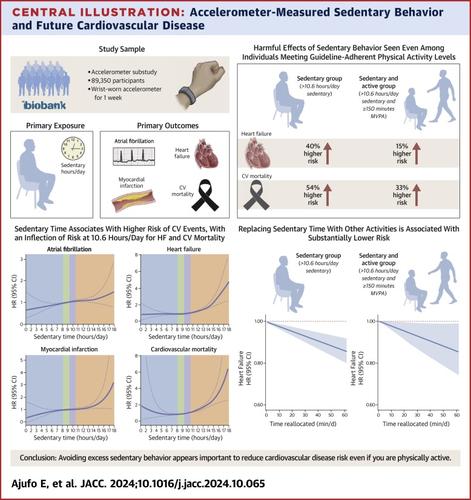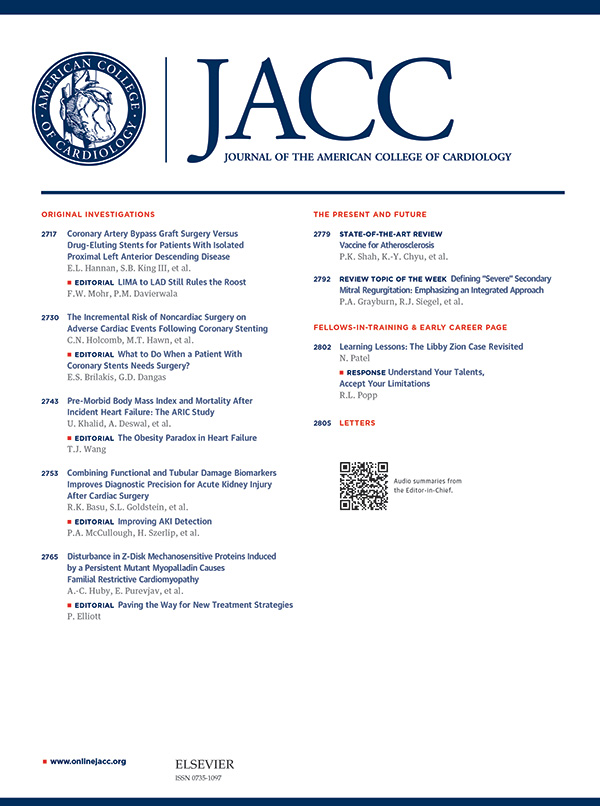加速计测量的久坐行为与未来心血管疾病风险
IF 21.7
1区 医学
Q1 CARDIAC & CARDIOVASCULAR SYSTEMS
引用次数: 0
摘要
背景除了作为体力活动不足的标志外,久坐行为还可能直接影响未来的心血管疾病(CV)风险。目的本研究试图探讨加速计测量的久坐行为与特定 CV 结果风险之间的关系,包括与中度到剧烈体力活动(MVPA)之间的潜在关系。方法在英国生物库前瞻性队列研究的参与者中,我们拟合了经人口统计学和生活方式因素调整的 Cox 模型,以评估加速计测量的每日久坐时间与心房颤动 (AF)、心肌梗死 (MI)、心力衰竭 (HF) 和冠心病死亡率之间的关系。我们评估了 MVPA 对久坐时间与冠心病之间关系的潜在影响,方法是将 MVPA 作为调整变量,并按照指南推荐的 MVPA 阈值(即≥150 分钟/周)进行分层亚组分析。结果在接受 1 周加速度测量的 89,530 人(年龄 62 ± 8 岁,56.4% 为女性)中,久坐时间中位数为 9.4 小时/天(Q1-Q3:8.2-10.6)。在多变量模型中,以第二四分位数(8.2-9.4 小时/天)为参照,久坐时间在前四分位数(10.6 小时/天)的人患心房颤动(HR:1.45;95% CI:1.28-1.65)和心血管疾病死亡(HR:1.62;95% CI:1.34-1.96)的风险更大,风险在 10.6 小时/天时出现拐点。久坐时间越长,发生房颤(HR:1.11;95% CI:1.01-1.21)和心肌梗死(HR:1.15;95% CI:1.00-1.32)的风险越高,两者之间呈近似线性关系。在达到指南推荐的 MVPA 水平的人群中,与心房颤动和心血管疾病死亡率的关系依然存在。在久坐时间为 10.6 小时/天的人群中,将久坐行为重新分配到其他活动大大降低了久坐行为带来的超额心血管疾病风险(例如,减少 30 分钟的久坐时间,心房颤动:HR:0.93;95% CI:0.90-0.96),即使在达到指南推荐水平的人群中也是如此。结论久坐行为与未来的不良心血管疾病结局密切相关,对心房颤动和心血管疾病死亡率的影响尤为显著,其风险在大约 10.6 小时/天时出现拐点。虽然遵循指南的 MVPA 可部分缓解过高的风险,但即使在体力活动量大的人群中,优化久坐行为似乎也很重要。本文章由计算机程序翻译,如有差异,请以英文原文为准。

Accelerometer-Measured Sedentary Behavior and Risk of Future Cardiovascular Disease
Background
Beyond serving as a marker for insufficient physical activity, sedentary behavior may directly affect future cardiovascular (CV) disease risk.
Objectives
This study sought to examine associations between accelerometer-measured sedentary behavior with risk of specific CV outcomes, including potential relations with moderate to vigorous physical activity (MVPA).
Methods
Among participants of the UK Biobank prospective cohort study, we fit Cox models adjusted for demographic and lifestyle factors to assess associations between accelerometer-measured daily sedentary time with incident atrial fibrillation (AF), myocardial infarction (MI), heart failure (HF), and CV mortality. We assessed the potential effect of MVPA on associations between sedentary time and CV disease by including MVPA as an adjustment variable, as well as performing subgroup analyses stratified at the guideline-recommended MVPA threshold (ie, ≥150 min/wk). We then performed compositional analyses to estimate the effects of reallocating sedentary time to other activities.
Results
Among 89,530 individuals (age 62 ± 8 years, 56.4% women) undergoing 1 week of accelerometry, median sedentary time was 9.4 h/d (Q1-Q3: 8.2-10.6). In multivariable models, using the second quartile (8.2-9.4 h/d) as a referent, sedentary time in the top quartile (>10.6 h/d) was associated with greater risks of HF (HR: 1.45; 95% CI: 1.28-1.65) and CV mortality (HR: 1.62; 95% CI: 1.34-1.96), with an inflection of risk at 10.6 h/d. Higher sedentary time was also associated with greater risks of incident AF (HR: 1.11; 95% CI: 1.01-1.21) and MI (HR: 1.15; 95% CI: 1.00-1.32), with an approximately linear relation. Associations with HF and CV mortality persisted among individuals meeting guideline-recommended MVPA levels. Among individuals with >10.6 h/d of sedentary time, reallocating sedentary behavior to other activities substantially reduced the excess CV risk conferred by sedentary behavior (eg, 30-minute decrease in sedentary time for HF: HR: 0.93; 95% CI: 0.90-0.96), even among individuals meeting guideline-recommended MVPA (HR: 0.93; 95% CI: 0.87-0.99).
Conclusions
Sedentary behavior is broadly associated with future adverse CV outcomes, with particularly prominent effects on HF and CV mortality, where risk inflected at approximately 10.6 h/d. Although guideline-adherent MVPA partially mitigates excess risk, optimizing sedentary behavior appears to be important even among physically active individuals.
求助全文
通过发布文献求助,成功后即可免费获取论文全文。
去求助
来源期刊
CiteScore
42.70
自引率
3.30%
发文量
5097
审稿时长
2-4 weeks
期刊介绍:
The Journal of the American College of Cardiology (JACC) publishes peer-reviewed articles highlighting all aspects of cardiovascular disease, including original clinical studies, experimental investigations with clear clinical relevance, state-of-the-art papers and viewpoints.
Content Profile:
-Original Investigations
-JACC State-of-the-Art Reviews
-JACC Review Topics of the Week
-Guidelines & Clinical Documents
-JACC Guideline Comparisons
-JACC Scientific Expert Panels
-Cardiovascular Medicine & Society
-Editorial Comments (accompanying every Original Investigation)
-Research Letters
-Fellows-in-Training/Early Career Professional Pages
-Editor’s Pages from the Editor-in-Chief or other invited thought leaders

 求助内容:
求助内容: 应助结果提醒方式:
应助结果提醒方式:


